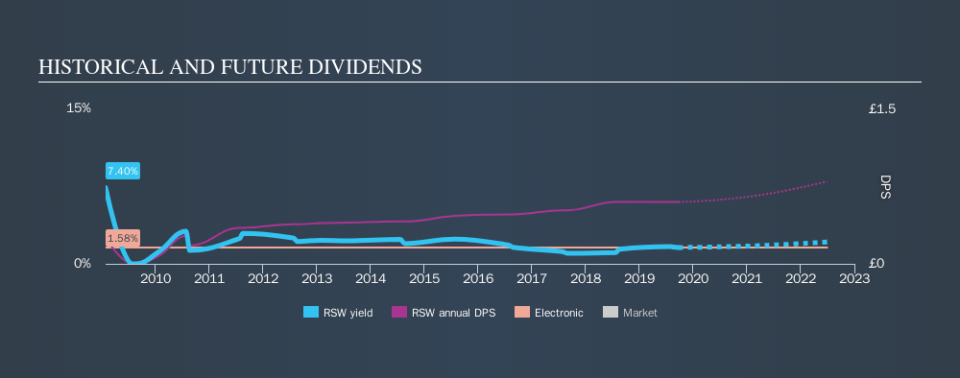Should Income Investors Look At Renishaw plc (LON:RSW) Before Its Ex-Dividend?

It looks like Renishaw plc (LON:RSW) is about to go ex-dividend in the next 2 days. This means that investors who purchase shares on or after the 26th of September will not receive the dividend, which will be paid on the 31st of October.
Renishaw's next dividend payment will be UK£0.5 per share. Last year, in total, the company distributed UK£0.6 to shareholders. Calculating the last year's worth of payments shows that Renishaw has a trailing yield of 1.6% on the current share price of £37.74. We love seeing companies pay a dividend, but it's also important to be sure that laying the golden eggs isn't going to kill our golden goose! That's why we should always check whether the dividend payments appear sustainable, and if the company is growing.
See our latest analysis for Renishaw
If a company pays out more in dividends than it earned, then the dividend might become unsustainable - hardly an ideal situation. Renishaw paid out a comfortable 47% of its profit last year. Yet cash flow is typically more important than profit for assessing dividend sustainability, so we should always check if the company generated enough cash to afford its dividend. Over the past year it paid out 148% of its free cash flow as dividends, which is uncomfortably high. We're curious about why the company paid out more cash than it generated last year, since this can be one of the early signs that a dividend may be unsustainable.
Renishaw paid out less in dividends than it reported in profits, but unfortunately it didn't generate enough cash to cover the dividend. Were this to happen repeatedly, this would be a risk to Renishaw's ability to maintain its dividend.
Click here to see the company's payout ratio, plus analyst estimates of its future dividends.
Have Earnings And Dividends Been Growing?
Stocks with flat earnings can still be attractive dividend payers, but it is important to be more conservative with your approach and demand a greater margin for safety when it comes to dividend sustainability. If business enters a downturn and the dividend is cut, the company could see its value fall precipitously. It's not encouraging to see that Renishaw's earnings are effectively flat over the past five years. We'd take that over an earnings decline any day, but in the long run, the best dividend stocks all grow their earnings per share. Earnings have been growing somewhat, but we're concerned dividend payments consumed most of the company's cash flow over the past year.
Many investors will assess a company's dividend performance by evaluating how much the dividend payments have changed over time. In the last ten years, Renishaw has lifted its dividend by approximately 9.0% a year on average.
Final Takeaway
Has Renishaw got what it takes to maintain its dividend payments? Earnings per share have barely grown in this time, and although Renishaw is paying out a low percentage of its profit, its dividend was not well covered by free cash flow. Only rarely do we find companies paying out a low percentage of their profits yet a high percentage of their cash flow, so we'd mark this as a concern. Overall, it's hard to get excited about Renishaw from a dividend perspective.
Wondering what the future holds for Renishaw? See what the nine analysts we track are forecasting, with this visualisation of its historical and future estimated earnings and cash flow
If you're in the market for dividend stocks, we recommend checking our list of top dividend stocks with a greater than 2% yield and an upcoming dividend.
We aim to bring you long-term focused research analysis driven by fundamental data. Note that our analysis may not factor in the latest price-sensitive company announcements or qualitative material.
If you spot an error that warrants correction, please contact the editor at editorial-team@simplywallst.com. This article by Simply Wall St is general in nature. It does not constitute a recommendation to buy or sell any stock, and does not take account of your objectives, or your financial situation. Simply Wall St has no position in the stocks mentioned. Thank you for reading.

 Yahoo Finance
Yahoo Finance 
